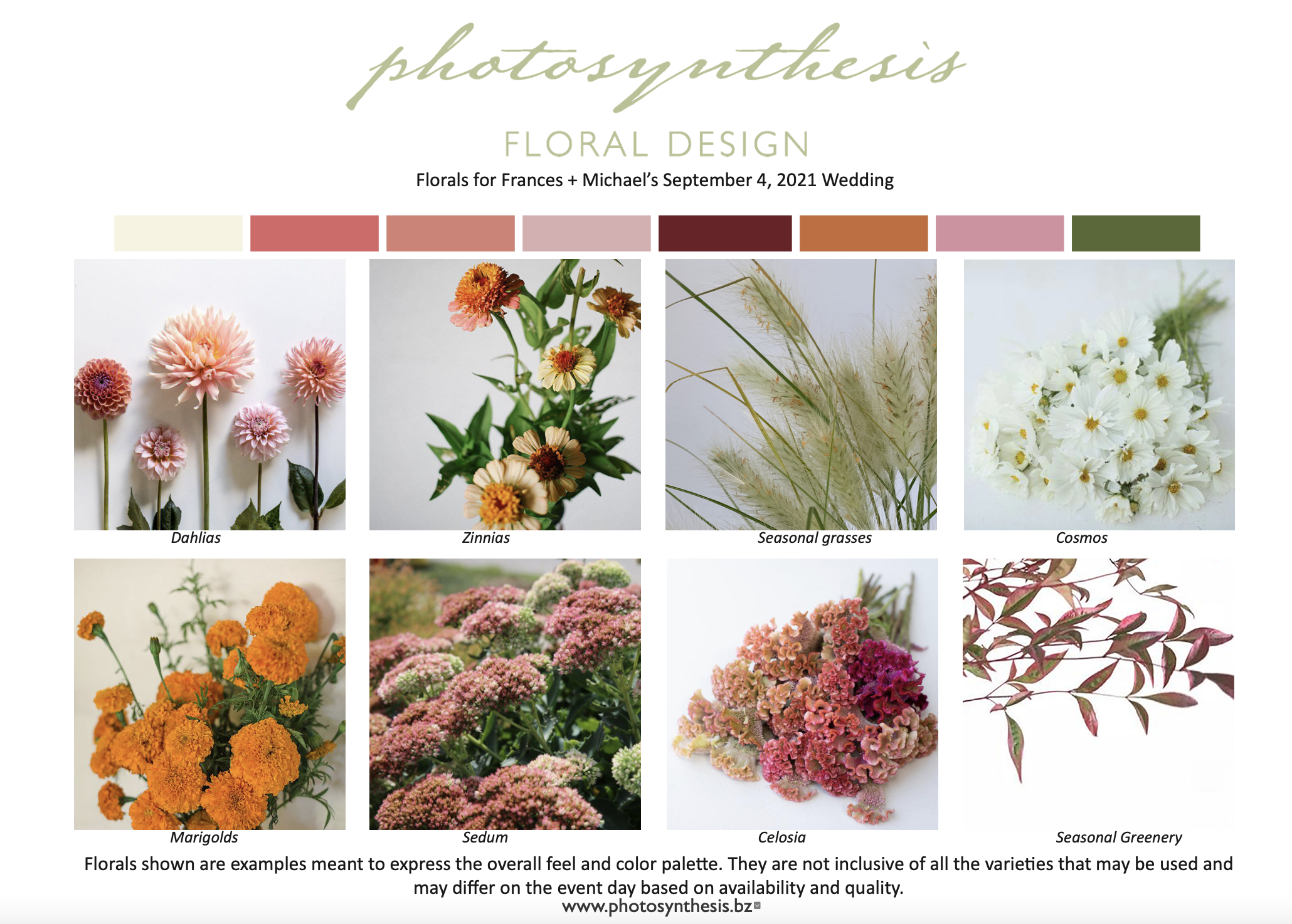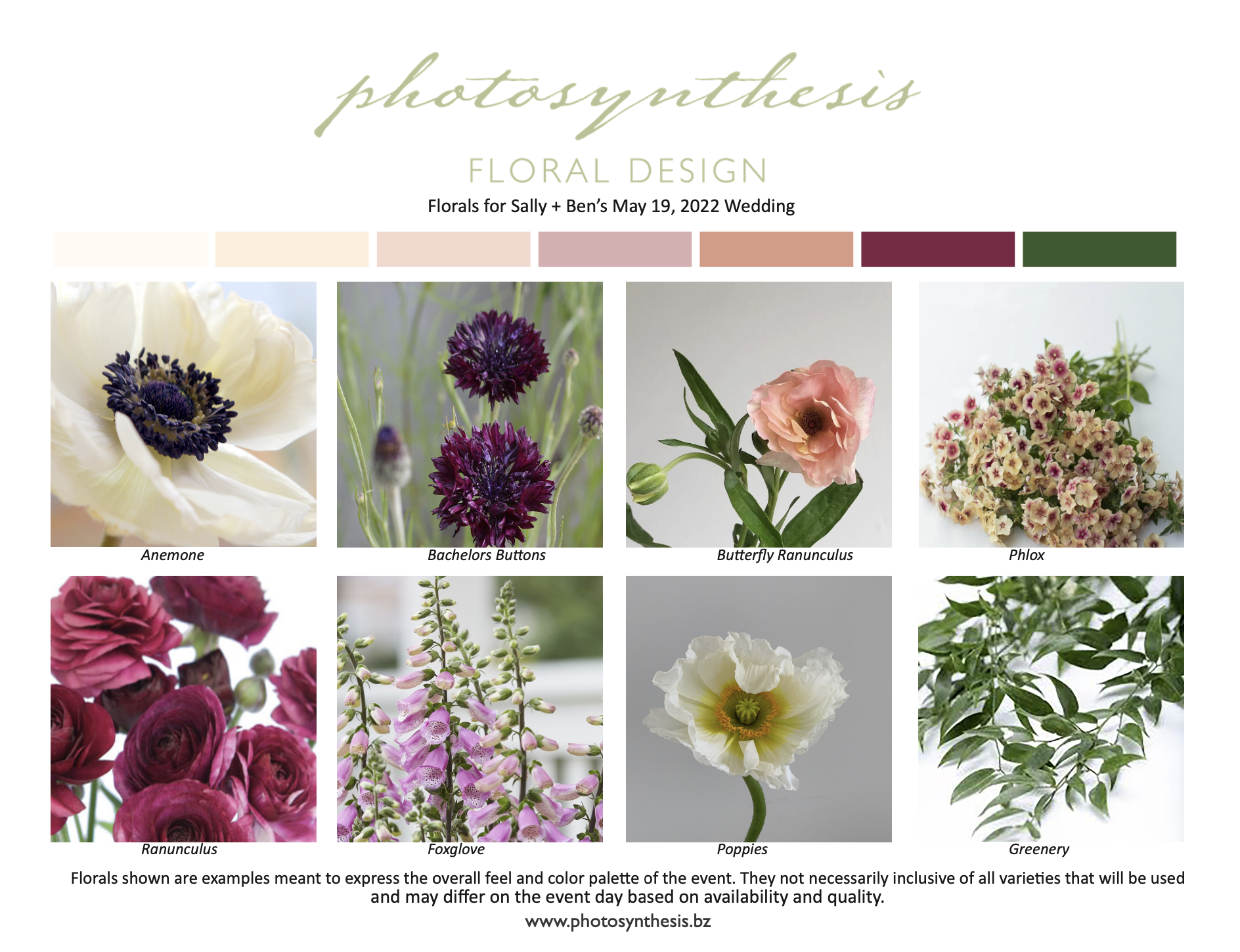Photo credit: Peyton Curry; Florals, Amanda Burnette; Bride, Hillary Carr, Vessel and Stem
Part two in our series for florists and designers working with local product is about three key areas to consider during your proposal-building process:
- Contract Clauses for Market Substitutes
- Proposals and Flower Boards
- Descriptive Language
Related: Check out part 1 of this series - Designers Guide for Embracing Seasonality & Setting Expectations.
Contract Clauses
You have done so much work to educate your client on your design process and values. Now it is time to have it in writing! Adding a clause about substitutions to your contract further sets the expectation that you are the trusted expert, and that you have your client’s best interests in mind. It can be very simple: you have the freedom to substitute as needed to achieve the best look and quality of deliverables. Any large changes that need to be made will be communicated to the client, but otherwise, you have the discretion to make substitutions to give them the highest quality product. (Note: Rooted is not offering legal advice and would advise individuals with contract-related questions to seek advice with credentialed legal counsel.)
Substitutions: [COMPANY] reserves the right to make substitutions in the event the flowers or decor received are not of the quality suitable to [EVENT]. The integrity of the proposed look and color scheme will be maintained, and flowers of equivalent aesthetic or monetary value will be used.
“I have a clause in my contract that states I have the right to change blooms and adjust the palette as needed without the client’s approval in order to ensure the expected level of quality. I explain to people that flowers can come in looking bad: beaten up in transit, with lots of breakage, too tight or too open, or the color can be 'off”'. I ask for their trust and the freedom to make substitutes at the last minute." Tobey Nelson, Tobey Nelson Events & Design
Proposals and Flower Boards
This is your chance to show off how amazing you are at turning your client’s ideas into reality. Flower boards (also known as mood boards) serve several important purposes, including helping your client feel recognized and understood, clarifying the vision, and ensuring everyone is agreeing on a direction. Continue on your path to not promise specific blooms (you’re doing great!). Including only flowers (or mostly flowers) available locally and in alignment with the timing of your client’s event will further set the expectation that you use what is in season.
“I promise them a vibe, a color story, not a list of exact ingredients that are going to go into this. It gives me freedom to be creative but it’s not so stressful for me if for example, the sweet peas are all dead. It’s a more realistic way to work and it’s more environmentally friendly. I’ve been trained as a sculptor and painter and you’re hiring me as an artist and to make something beautiful. No arrangement will necessarily be the same. If we have 30 table arrangements, each one is a work of art. I explain that off the bat.” Sarah Saunders, Sarah Saunders Studio
Below are a few flower board examples from Photosynthesis Floral Design that focus on color palette, design elements, and mood. 

Descriptive Language
In addition to the visuals, it is equally important to use descriptive language. Words like lush, textural, rounded, wild, or clean can be effective in conveying mood and communicating a specific feeling for an event. For example, words like ‘wild’ or ‘natural’ can connotate a more organic and free-spirited feel, while ‘clean’ can signify a more modern or minimalist look.
Below are a few description examples from proposals:
“A medium-sized bridal bouquet in tones of pink, peach, and cream, with a focus on fluffy rounded flowers that may include peony, rose, double-flowered tulips, and the like. The work will possess the spirit of the attached inspirational image in terms of texture, color, and composition." Tobey Nelson, Tobey Nelson Events and Design
“…an organically structured bouquet of seasonal, locally grown flowers in shades of ivory, blush, and terracotta” Sarah Lambert Freeman, Hive and Hollow
Using visual tools like flower boards is a critical step to having clear communication and further establishes your flower expertise. Having a concise contract further ensures you are all on the same page and there aren’t any last-minute unwanted surprises!
Categories

About the Author
Rooted Farmers
The Rooted Farmers Team is happy to bring you content that we hope provides value. The topics covered range from farming and running a hub, to sales, marketing, and all things related to building your business, to the unique challenges faced by growers. Our philosophy in sharing this content is that we are always in a position to learn; embracing this mentality will only help us to grow, both within our businesses and personally. If there is a topic that you feel would be of value to the Rooted Farmers community, we encourage you to share your ideas with us by sending an email to: reachout@rootedfarmers.com
